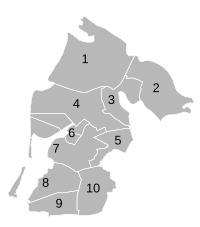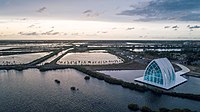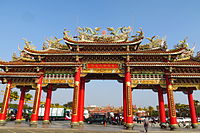Trash (Tainan)
|
Beimen 北門區 |
||
 Location of Beimen in Tainan |
||
| State : |
|
|
| Coordinates : | 23 ° 17 ' N , 120 ° 8' E | |
| Area : | 44.1003 km² | |
| Residents : | 11,013 (Feb. 2019) | |
| Population density : | 250 inhabitants per km² | |
| Time zone : | UTC + 8 (Chungyuan time) | |
| Telephone code : | (+886) (0) 6 | |
| Postal code : | 727 | |
| ISO 3166-2 : | TW-TNN | |
| Community type : | Municipality of Tainan | |
| Structure : | 10 districts ( 里 , Lǐ ) | |
| Website : | ||
|
|
||
Beimen ( Chinese 北 門 區 , Pinyin Běimén Qū , Pe̍h-ōe-jī Pak-mn̂g-khu ) is a district of the government -direct city of Tainan in the southwest of the Republic of China in Taiwan .
Location and description
Beimen is located in the extreme northwest corner of the urban area of Tainan. The district includes a coastline of around 12 kilometers north-south and the associated hinterland at a depth of up to 8 kilometers. Beimen is characterized by the coastal landscape with numerous salt lagoons and has a flat topography with no major elevations. Geologically, the area consists of alluvial soil , which was only formed in the last few centuries by sediment deposits from the rivers that flow into the Taiwan Strait . In the area of the district, three rivers flow into the Taiwan Strait. The northern border of Beimen is the Bazhang River ( 八掌溪 , Bāzhǎng Xī ), the southern border is the small Jiangjun River ( 將軍 溪 , Jiāngjūn Xī ) and the Jishui River ( 急水溪 , Jíshuǐ Xī ) runs in the middle .
The neighboring boroughs of Tainan are Jiangjun in the south and Xuejia in the east. To the north, Beimen borders the two municipalities of Budai and Yizhu in the district of Chiayi .
history
Today's Beimen originated from an island that was off the mouth of the Jishui River. Until 1920, the place was known as Beimen Island ( 北 門 嶼 ). In earlier centuries, Beimen formed a kind of entrance to the later silted up Daofeng lagoon ( 倒 風 內海 , Dàofēng Nèihǎi ) further inland, from where the place name possibly results ( 北 門 , Běimén - "northern gate"). Historically, salt production was of greater importance. During the Japanese rule in Taiwan (1895-1945), Beimen was organized in 1920 administratively as a 'village' ( 庄 , Zhuāng , Japan. Shō ). After the Republic of China took over Taiwan in 1945, the village became the rural community of Beimen ( 北 門 鄉 , Běimén Xiāng ) in the newly founded Tainan County . The district was completely incorporated into the city of Tainan on December 25, 2010 and Beimen received the status of a city district ( 區 , Qū ).
population
With around 11,000 inhabitants (2019), Beimen was one of the less populous districts of Tainan. Members of indigenous peoples only make up a negligibly small proportion (just under 0.2%).
| Outline of accessories |

|
Administrative division
An administrative reform took place on January 29, 2018 and April 30, 2018 and the number of districts ( 里 , Lǐ ) was reduced from 13 to 10.
1. Shuangchun ( 雙 春 里 )
2. Jinhu ( 錦湖 里 )
3. Heliao ( 蚵 寮 里 )
4. Baoji ( 保 吉 里 )
5. Yugang ( 玉 港 里 )
6. Yonglong ( 永隆 里 )
7. Beimen ( 北 門 里 )
8. Ci'an ( 慈安 里 )
9. Sanguang ( 三光 里 )
10. Wenshan ( 文山 里 )
traffic
The most important traffic artery is the provincial expressway 67, which runs parallel to the coast in north-south direction. Two larger roads branch off from this: on the one hand, provincial road 17, which runs in south-south-west direction and also takes a longer route through Beimen, and on the other hand, Provincial Expressway 84, which goes directly west. There are also several county roads (171, 173, 174A / 174 甲 ).
Agriculture and fishing
Aquaculture is very important. At the end of 2017, more than 2000 hectares of the district's area were used for fish farming. Only about 900 hectares were used for agriculture. The relatively salty soils are not suitable for growing rice. The quantitatively most important products were corn, soybeans, sweet potatoes, watermelons and onions.
Special features and tourist destinations
Beimen part of the National Scenic Area south west coast ( 雲嘉南國家風景區 , Yúnjiānán Guojia Fēngjǐng Qū , Southwest Coast National Scenic Area ' ), an area that is to be developed specifically for tourism. The Beien lagoon is known for its atmospheric sunsets. In 2014, a small visitor building, the name was opened on the lagoon, due to its glass and church-like architecture Crystal Church ( 北門水晶教堂 , Shuǐjīng Jiaotang , Crystal Church ' ) has received.
![]()
In the Taoist Nankunshen Daitian Temple ( 南 鯤 鯓 代天府 , Nánkūnshēn Dàitiānfǔ , ) Wang Ye ( 王爺 , Wángyé ), a deity of Chinese folk beliefs, is worshiped. According to tradition, the temple was founded in the 17th century at the place where an unmanned boat with images of five Chinese deities was stranded. Today's temple complex is largely due to renovations and new constructions from 1817 and again from 1923. The Donglong Temple ( 東 隆 宮 , ) in the Sanguang district goes back to a shrine that was built in 1673.
![]()
![]()
In earlier times, the so-called blackfoot disease ( 烏 腳 病 , Wūjiǎo Bìng , 'Blackfoot disease' ) occurred endemically in Beimen (as well as in the neighboring coastal regions of southern Taiwan, in particular Xuejia , Xiaying , Yizhu and Budai ) . This was a slowly progressing vascular occlusive disease in which necrosis and gangrene developed , especially on the lower extremities, which subsequently made amputations necessary. The cause was chronic arsenic poisoning , which was caused by the naturally increased arsenic content of the groundwater due to the deposited sediments. Most affected were poor people who had no access to the central water supply and therefore used the groundwater from deep wells. The disease reached its peak in the period from 1956 to 1960. With the introduction of a central water supply, it practically disappeared completely. The Taiwanese Memorial House for the Sociomedical Care of Black Foot's Disease ( 台灣 烏 腳 病 醫療 紀念館 , Táiwān Wūjiǎo Bìng Yīliáo Jìniànguǎn , ) in the district of Shuangchun reminds of the medical problems of that time .
![]()
Web links
Individual evidence
- ↑ 本 區 簡介 ("Presentation of the district"). Beimen website, December 26, 2018, accessed May 9, 2019 (Chinese (traditional)).
- ↑ 歷史 沿革 ("Historical Development"). Beimen website, May 17, 2018, accessed May 9, 2019 (Chinese (traditional)).
- ↑ 原住民 戶數 及 人數 Households and Persons of Indigenous People. (xls) Taiwan Ministry of the Interior, accessed May 5, 2018 (Chinese, English).
- ↑ 臺南市 里 鄰 編組 及 調整 情形 一覽表 ("List of Adjustments to Neighborhoods in Tainan City"). Retrieved April 1, 2019 (Chinese (traditional), borders before and after the 2018 adjustment ( PDF )).
- ↑ 會計 專欄 - 統計 專區> 統計 專區 (“Statistical report for the year 106 (according to the Minguo calendar)”). Beimen website, August 1, 2018, accessed May 9, 2019 (Chinese (traditional)).
- ↑ Beimen Lagoon (北 門 潟湖). Tainan Tourism Office, December 13, 2018, accessed May 8, 2019 .
- ↑ Beimen Crystal Church (北門水晶教堂). twtaiwan.net (Taiwan Tourism Office), February 26, 2019, accessed on May 9, 2019 .
- ↑ 南 鯤 鯓 代天府 nan kun shen dai tian temple. Temple website, accessed May 9, 2019 (Chinese (traditional), English).
- ↑ Beimen Donglong Temple (北 門 東 隆 宮). twtaiwan.net (Taiwan Tourism Office), December 13, 2018, accessed May 9, 2019 .
- ^ Tseng CH: Blackfoot disease and arsenic: a never-ending story . In: J Environ Sci Health C Environ Carcinog Ecotoxicol Rev . tape 23 , no. 1 , 2005, p. 55-74 , doi : 10.1081 / GNC-200051860 , PMID 16291522 (English).
- ↑ Jiin-Shuh Jean, Jochen Bundschuh, Chien-Jen Chen, How-Ran Guo, Chen-Wuing Liu, Tsair-Fuh Lin, Yen-Hua Chen: The Taiwan Crisis: a showcase of the global arsenic problem . CRC Press / Balkema, 2010, ISBN 978-1-4398-5948-3 , 3.4 Epidemiological characteristics of Blackfoot disease (English).
- ↑ 台灣 烏 腳 病 醫療 紀念館 Taiwan Blackfoot Disease Socio-Medical Service Memorial House. Website of the memorial house, accessed on May 9, 2019 (Chinese (traditional), English).




